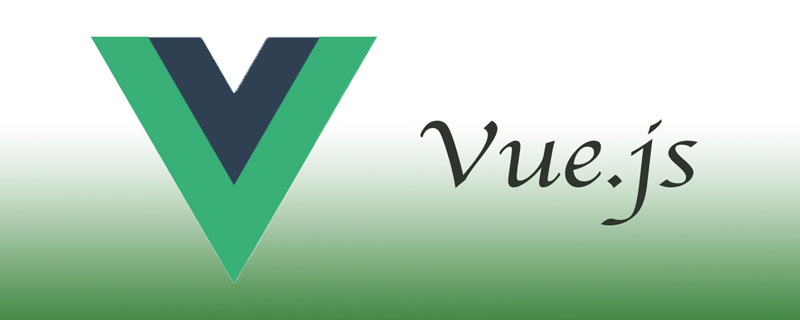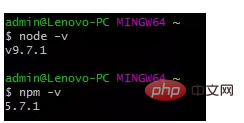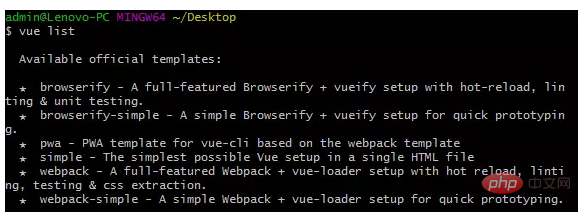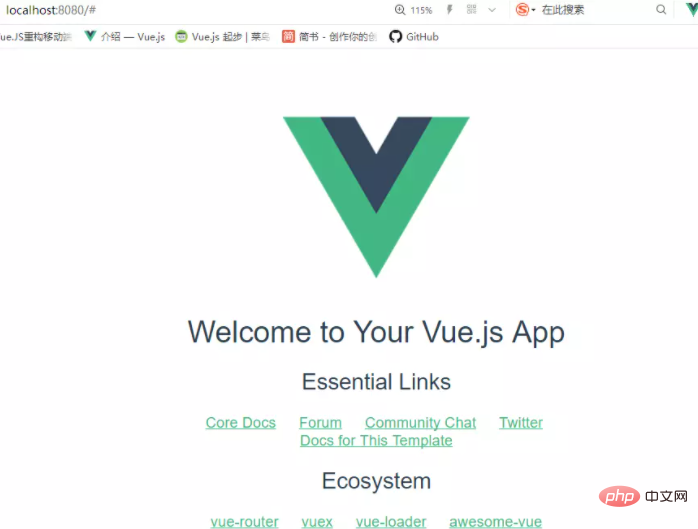What needs to be installed to install vue.js
Installing vue.js requires installing node.js. The specific method of installing vue.js is: first install node.js; then install the Taobao image; then install Vue, and install the global vue-cli scaffolding; finally Just check whether Vue is installed successfully.

The operating environment of this tutorial: windows7 system, vue2.0&&Node.js v14.15.3 version, Dell G3 computer.
Related recommendations: "vue.js Tutorial"
What do I need to install before installing vue.js?
You need to install node.js before installing vue.js. Just install the latest version from the official website. The version should be greater than version 6.0.
In this way, you can use the npm tool that comes with node.js to install vue.js and its related tools.
npm: Package manager under Nodejs. npm can be used to install, share, distribute code, and manage project dependencies.
Using npm to install Vue can facilitate package management. Then use the Vue command directly, and use the webpack tool to create the project. The front-end build tool will make front-end development more efficient.
Steps to install vue.js using npm
Step 1: Install node.js
As shown in the figure below, enter the following command on the terminal Make sure node.js is installed on your computer and the npm version is greater than 3.0. If the npm version is less than 3.0, you can enter $ cnpm install npm -g to upgrade.

Step 2: Install Taobao image
Since npm installation speed is slow, this article uses Taobao image and its command cnpm to install, enter $ npm install - g cnpm --registry=https://registry.npm.taobao.org install Taobao mirror.
Step 3: Install Vue
Enter $ cnpm install vue, press Enter and wait for the terminal to respond.
Step 4: Install the global vue-cli scaffolding
Enter $ cnpm install --global vue-cli to install the global vue-cli scaffolding, which is used to quickly build large single-page applications.
Step 5: Check whether Vue is installed successfully
Enter $ vue -V to check whether the installation is successful. If the version number is returned, the installation is successful.

The version number appears indicating that the installation is successful
Step 6: Check the template provided by the official website (this step can be omitted)

Among the six templates, we mainly use webpack templates for the following reasons:
WebPack can be regarded as a module packager: what it does is to analyze your project structure and find JavaScript modules As well as other extension languages that cannot be run directly by browsers (Scss, TypeScript, etc.), they are packaged into a suitable format for use by browsers.
Step 7: Create a new project based on the webpack template
Switch the terminal to your target directory and create a project. Here is an example of creating a project called vue-project on the desktop: Enter vue init webpack vue-project, and the terminal will return the following content to you:
# 这里需要进行一些配置,默认回车即可
This will install Vue 2.x version of the template.
For Vue 1.x use: vue init webpack#1.0 vue-project
? Project name vue-project
? Project description A Vue.js project
? Author 5Iris5 <1847370****@163.com>
? Vue build standalone
? Use ESLint to lint your code? Yes
? Pick an ESLint preset Standard
? Setup unit tests with Karma + Mocha? Yes
? Setup e2e tests with Nightwatch? Yes
vue-cli · Generated "my-project".
To get started:
cd vue-project
npm install
npm run dev
Documentation can be found at https://vuejs-templates.github.io/webpackThe original image is not placed here because I made a mistake in this link, and the reason will be recorded in detail later. Under normal circumstances, after running to this step, your interface should appear in sequence with the three commands shown above.
Step 8: Enter the following three commands in sequence according to the prompts
// 进入项目 $ cd vue-project // 安装依赖 $ cnpm install // 测试环境是否搭建成功 $ cnpm run dev
Step 9: Run
After successfully executing the above commands, visit http://localhost:8080/ and output the results As follows:

The above is the detailed content of What needs to be installed to install vue.js. For more information, please follow other related articles on the PHP Chinese website!

Hot AI Tools

Undresser.AI Undress
AI-powered app for creating realistic nude photos

AI Clothes Remover
Online AI tool for removing clothes from photos.

Undress AI Tool
Undress images for free

Clothoff.io
AI clothes remover

Video Face Swap
Swap faces in any video effortlessly with our completely free AI face swap tool!

Hot Article

Hot Tools

Notepad++7.3.1
Easy-to-use and free code editor

SublimeText3 Chinese version
Chinese version, very easy to use

Zend Studio 13.0.1
Powerful PHP integrated development environment

Dreamweaver CS6
Visual web development tools

SublimeText3 Mac version
God-level code editing software (SublimeText3)

Hot Topics
 1666
1666
 14
14
 1426
1426
 52
52
 1328
1328
 25
25
 1273
1273
 29
29
 1254
1254
 24
24
 In-depth discussion of how vite parses .env files
Jan 24, 2023 am 05:30 AM
In-depth discussion of how vite parses .env files
Jan 24, 2023 am 05:30 AM
When using the Vue framework to develop front-end projects, we will deploy multiple environments when deploying. Often the interface domain names called by development, testing and online environments are different. How can we make the distinction? That is using environment variables and patterns.
 Detailed graphic explanation of how to integrate the Ace code editor in a Vue project
Apr 24, 2023 am 10:52 AM
Detailed graphic explanation of how to integrate the Ace code editor in a Vue project
Apr 24, 2023 am 10:52 AM
Ace is an embeddable code editor written in JavaScript. It matches the functionality and performance of native editors like Sublime, Vim, and TextMate. It can be easily embedded into any web page and JavaScript application. Ace is maintained as the main editor for the Cloud9 IDE and is the successor to the Mozilla Skywriter (Bespin) project.
 What is the difference between componentization and modularization in vue
Dec 15, 2022 pm 12:54 PM
What is the difference between componentization and modularization in vue
Dec 15, 2022 pm 12:54 PM
The difference between componentization and modularization: Modularization is divided from the perspective of code logic; it facilitates code layered development and ensures that the functions of each functional module are consistent. Componentization is planning from the perspective of UI interface; componentization of the front end facilitates the reuse of UI components.
 Explore how to write unit tests in Vue3
Apr 25, 2023 pm 07:41 PM
Explore how to write unit tests in Vue3
Apr 25, 2023 pm 07:41 PM
Vue.js has become a very popular framework in front-end development today. As Vue.js continues to evolve, unit testing is becoming more and more important. Today we’ll explore how to write unit tests in Vue.js 3 and provide some best practices and common problems and solutions.
 Let's talk about how to use the Amap API in vue3
Mar 09, 2023 pm 07:22 PM
Let's talk about how to use the Amap API in vue3
Mar 09, 2023 pm 07:22 PM
When we used Amap, the official recommended many cases and demos to us, but these cases all used native methods to access and did not provide demos of vue or react. Many people have written about vue2 access on the Internet. However, in this article, we will take a look at how vue3 uses the commonly used Amap API. I hope it will be helpful to everyone!
 How to query the current vue version
Dec 19, 2022 pm 04:55 PM
How to query the current vue version
Dec 19, 2022 pm 04:55 PM
There are two ways to query the current Vue version: 1. In the cmd console, execute the "npm list vue" command to query the version. The output result is the version number information of Vue; 2. Find and open the package.json file in the project and search You can see the version information of vue in the "dependencies" item.
 A simple comparison of JSX syntax and template syntax in Vue (analysis of advantages and disadvantages)
Mar 23, 2023 pm 07:53 PM
A simple comparison of JSX syntax and template syntax in Vue (analysis of advantages and disadvantages)
Mar 23, 2023 pm 07:53 PM
In Vue.js, developers can use two different syntaxes to create user interfaces: JSX syntax and template syntax. Both syntaxes have their own advantages and disadvantages. Let’s discuss their differences, advantages and disadvantages.
 A brief analysis of how vue implements file slicing upload
Mar 24, 2023 pm 07:40 PM
A brief analysis of how vue implements file slicing upload
Mar 24, 2023 pm 07:40 PM
In the actual development project process, sometimes it is necessary to upload relatively large files, and then the upload will be relatively slow, so the background may require the front-end to upload file slices. It is very simple. For example, 1 A gigabyte file stream is cut into several small file streams, and then the interface is requested to deliver the small file streams respectively.




